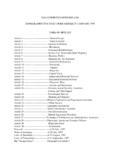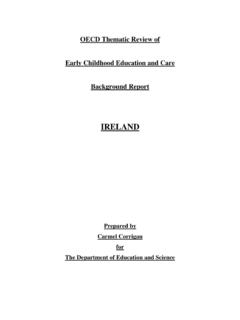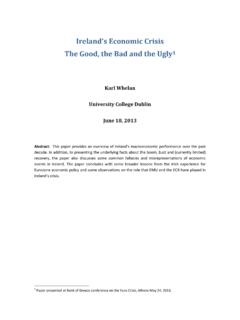Transcription of Growing apples, pears and plums at home in Ireland
1 1 Growing apples, pears and plums at home in Ireland If you have not yet planted your fruit trees, you have the opportunity to select the exact varieties and rootstocks that you want. Section 1. (For those who have not yet planted their fruit trees). Step 1. Select a rootstock. The main consideration when selecting your rootstock is how large you would like your tree to grow. Fruit trees, when grown on their own roots, produce large or very large trees. If you have a smaller space, or do not wish to climb to harvest your fruits, you should opt for a tree propagated on a rootstock. Rootstocks have been used for thousands of years, and the process of grafting or budding a tree onto a rootstock is not difficult, and could be undertaken by a skilful gardener. Do bear in mind that the eventual tree size will depend on the rootstock choice and variety choice combined. For example, with plums , the variety Victoria is less vigorous than Opal, and so Victoria trees will always be smaller than Opal trees when grown on the same rootstock.
2 Apples: Sizes of apple trees on some common apple rootstocks: MM111 gives a 25% dwarfing effect : trees eventually 6-7 metres tall MM106 gives a 35% dwarfing effect : trees eventually 5-6 metres tall M26 gives a 50% dwarfing effect : trees eventually metres tall M9 gives a 65% dwarfing effect : trees eventually 3 metres tall M27 gives a 75% dwarfing effect : trees eventually 2 metres tall Rootstocks with the MM code have resistance to woolly aphid, a pest which attacks the roots and above-ground parts of apple trees. If MM rootstocks are selected, the roots (but not above-ground parts) of the plant will be resistant to attack. pears : Those who plant pears plant for their heirs . pears planted on their own roots take a long time before becoming productive; sometimes up to 40 years. The logic of using a 2rootstock, apart from controlling size, is therefore evident. European or common pears are planted on Quince rootstocks. Sizes of pear trees on some common rootstocks: Quince MA (Quince A): trees eventually 4 metres tall Quince MC (Quince C) : trees eventually 3 metres tall plums : Size of plum trees on some common rootstocks: Myrobalan B: only slightly dwarfing, but resistant to bacterial canker St.
3 Julien A: 40% dwarfing: trees eventually 4 metres tall Pixy: 50% dwarfing, but induces small fruit size VVA-1: 60% dwarfing: trees eventually 3 metres tall Step 2: Select your varieties: Apples: The selection criteria for the fruit you wish to grow are numerous. You may wish to preserve our genetic heritage, and choose traditional or uncommon varieties. The seedsavers association in Scarriff, Co. Clare, has apples that fulfil these criteria. Among my favourite apples of Irish origin are Irish Peach, Kerry Pippin (both ready early), Ard Cairn Russet, Kilkenny Pearmain, Eight Square, Reid s Seedling. The latter three are less well flavoured than the former. You may also decide to select based on resistance to disease, especially apple scab (black spot), which is very damaging in Ireland thanks to our damp spring and summer weather. Among the best scab- tolerant varieties are Discovery (but this is canker susceptible), Katy, Red Windsor (also called Alkmene or Cevaal) and Bramley s Seedling for cooking (but not when planted in a monoculture).
4 Scab resistant varieties are bred specifically for ability to withstand apple scab. However, bear in mind that resistance conferred by the gene making these apples scab resistant has broken down in wild apples, and may do so in the case of these also, especially if grown under circumstances favouring apple scab. 3 Among the best of the resistant varieties are: Rajka Retina Collina Topaz Dalinco Dalinbel Florina Vanda When planting apples you should choose two or three different varieties. While some self-pollinate, others do not, so three usually gives a good mix. Of the varieties mentioned on these pages, Bramley and Discovery need cross-pollination more than any of the others. Do remember that is there are apple trees in a nearby garden, or ornamental apples on the street, once they bloom at the same time as your fruit trees, the insects will carry the pollen to your tree, so in such a case you may not need more than one tree yourself. pears : The three varieties of pears that I have found to grow well in Ireland are Conference, Concord and Doyenne du Comice.
5 I would suggest planting all three to achieve good pollination and regular crops. A friend has Williams, and is very happy with it also. plums : The most reliable plum for Growing in Ireland is Victoria. Opal is less reliable, mainly due to winter stripping of fruit buds by Bullfinches, but they are superior in taste. Opal trees are more vigorous than Victoria, and will produce a tree almost twice as large on any given rootstock. Pollination of these varieties of plums is not an issue as they are self-fertile. 4 Step 3: Plant the trees In most cases planting is simple. Just plant as you would for a normal potted shrub or tree. However, remember that your fruit tree will almost certainly need to be tied to a post or stake, and that the rootstock union (swelling where the rootstock and variety meet) must be kept at least 10cm above the ground, as otherwise the tree may begin to grow on its own roots, undoing the good of having a rootstock in the first place. If you are planting in a wet area, make a mound of soil above the surrounding garden, perhaps 30cm higher, by 50cm all around, and plant the tree in the centre of the mound.
6 This will provide a relatively dry root zone. Section 2. ( Growing apples, pears and plums at home in Ireland ) Weed control Young fruit trees are not very well able to compete with weeds, and dwarf trees (on M9 rootstock for instance) are not very competitive, even when they get older. A substantially weed-free area needs to be maintained under trees for this reason. This can be achieved by hoeing, use of a mulch (artificial or natural), or spraying. Most gardeners choose one the earlier two options. Fertiliser Depending on the fertility of your soil, the tree may need additional fertiliser added. On our farm we use spent mushroom compost, but you could use ordinary garden compost, horse manure or farmyard manure, grass clippings, or artificial fertiliser. Composts and manures are preferable as they improve soil structure as well as soil fertility. Composts and manures may also be useful as weed suppressants for a period, by acting as mulches (see weed control above). Take care not to over manure trees.
7 This will encourage too much woody growth which will be disease-prone, and also reduces flowering and fruiting. You should be able to judge the fertility of your soil by the growth of grass nearby, or before you plant. If the grass is stunted and rarely needs cutting (say every two weeks) 5then extra fertility is needed. If you find you need to mow more than once a week in summer, there is probably adequate fertility. Pest control There are numerous pests which may attack fruit trees. For commercial fruit growers there are nowadays numerous non-chemical techniques to control these pests also; so much so it is quite possible that the apple you find in the supermarket has never been sprayed with an insecticide. Unfortunately, many of these environmentally-friendly methods of pest control have been developed for large-scale use, and do not work in a garden situation. Examples would include use of mating disruption, introduction of pest parasites and natural predators, sterile insect release programs, and more.
8 Because of the lack of options for garden-scale Growing (meaning that sometimes the only option in a garden is use of a chemical), it may be preferable to accept a certain level of pest damage in the garden. Apples, pears and plums : The main pest common to all these is fruit tree red spider mite. This will be controlled by naturally occurring predators in both commercial and garden situations, simply by being sure that you do not apply any chemical that damages these predators. plums : The principal pests of plums in Ireland are aphids (greenfly or blackfly) and plum moths. Aphids attack quite early in the year, and cause leaf curling and stunt the tree. They also secrete sticky honey dew which coats the plant (and fruit), and moulds can then grow on this. If you check your plants frequently (every day) for aphid attacks, you can stop an attack early by introducing predators. Ladybirds are the best known, though other better predators are available. See for more information or to buy the traps or predators.
9 Plum moths can be trapped using a phermone trap, but this works better on a large-scale than in the garden. See agralan again. 6 pears : I have not encountered any significant pest on my pear trees, though aphids could present a problem. Treat as per plums for this pest. Apples: A number of significant pests of apples occur in Ireland . Aphids and red spider mite can be controlled as already outlined for the other fruits above. In addition, a number of caterpillars, representing the young of a number of moth species, are problematic. Winter moth is relatively easy to control, because the females are wingless. Thus, overwintering moths must climb up from the soil to lay eggs on the tree; these later hatching and the caterpillars burrowing holes into the apples. Because they must crawl up the trunk, it is possible to grease-band (put a sticky band about 15cm wide) the trunk (and stake or post), catching the female on the way up, and thus ensuring that eggs are not laid. Codling moths and tortrix moths (our main one is the fruit tree tortrix) are harder to control, as they can fly.
10 Phermone traps will catch them, but perhaps not before they have laid their eggs. The caterpillars of codling eat into the apple causing worm in apple , or worse still, half-worm in half-eaten apple ) damage, while tortrix moths mostly feed near the surface. A note on winter-wash . Winter washes were traditionally advocated for garden-scale fruit producers. They are no longer recommended, as they are more environmentally damaging (and potentially damaging to human health) than anything a commercial producer might apply. While they do kill all manner of pests, their eggs, and diseases as well, they also kill beneficial organisms, which alters the natural balance which in turn leads to even more pest problems. Disease control In Ireland diseases of fruit trees present far more problems than pests. Our humid environment and mild winters favour apple scab, powdery mildew and apple canker. 7 Similar diseases affect pear, though not usually as severely, and they can be dealt with in the same way is I outline for apples.







